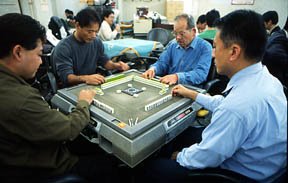Internet access in Japan was limited for me, so I apologize for the lack of updates.
After not being in Japan for over a year, it was a great trip, and I was able to make a few observations.
Part of the reason for the trip was to go to a wedding in Yokohama. The bride and groom are both young Japanese people, and I had never been to a wedding in Japan before, so I was looking forward to it.
The first thing that struck me was the amount of money that changes hands. As cousins of the bride, our family made a cash gift much larger than we would ever be expected to spend in the US. There are standards for how much friends and family should pay for a gift, and it is quite staggering. A friend in Japan was invited to three weddings in a month (none relatives) and ended up spending over a months salary in cash gifts. We now see single people often declining or making up excuses not to attend weddings simply because the cost of the money gift is so high (though, I have to admit, much simpler than the registry and shopping, etc...)
The interesting thing is that after the cost of the wedding, they would probably end up breaking even.
Hotels in Japan often have "chapels" for weddings in them, that way the wedding, reception, and out-of-town guests can all be in the same place. Set courses for the affair are all put together by the hotel, which makes for conveniece for the new bride and groom and insures nothing is forgotten. At the wedding we participated in there was a "wedding staff" who arranged everything, including photographer, videographer, kimono dresser (for the moms), and even babysitter. And, of course, the priest who held the ceremony.
The majority of Westerners working in Japan are English teachers. Less than 1% of Japanese citizens are Christian (as opposed to 25%+ in S. Korea), but Japanese weddings tend to follow the Christian pattern. (It is said in Japan you are born Shinto, marry Christian and die a Buddhist). This is likely for two reasons: 1) the traditional Japanese wedding is very beautiful, but very long and debilitatingly expensive and 2) the romantic impression of western weddings seen in movies and TV shows. What this means is there is a market for western priests to hold wedding ceremonies. There are certainly less ordained western Christian priests in Japan than the market demands, and the reality is that 80% of wedding ceremonies performed by non-Japanese are performed by actors, not actual priests (mostly English teachers looking for a little extra cash on the weekends). Does the marrying couple care? Probably not, and it may even be preferable this way.
The ceremony I attended was performed by an Australian gentlemen, and was almost completely in Japanese, and I almost couldn't tell if the nearly incomprehensible accect the "priest" spoke in was a put-on or his Japanese was really that bad. It reminded me of the "Gottsu 'A' Kanji" character, Mister Bater. A Kansai-ben spouting foreigner played by comedy team Downtown's Matsumoto. I hope this is a trend that doesn't continue in Japan, as it took away from the ceremony.
The reception was second-to-none with a five-course meal, live entertainment, and more waiters serving beer, wine, and champagne than I imagined could be in single room at one time. Service in Japan, especially for an event such as a wedding, is immaculate. A woman at the table I sat at preferred whiskey and water over wine or beer, and a glass was brought to her without question or complaint immediately upon her request. One by one we went to the bride and groom's table, (who sat at a long table facing the tables of guests) and gave our congrats and a toast. There is no telling how many toasts the groom drank, but I don't think he had time to eat, and was looking pretty happy by the end of the meal.








